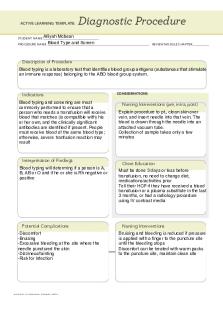Lab #1 and #2 Notes - Goniometry and Upper Quarter Screen PDF

| Title | Lab #1 and #2 Notes - Goniometry and Upper Quarter Screen |
|---|---|
| Course | Upper Extremity Assessment |
| Institution | University of Hawaii at Manoa |
| Pages | 3 |
| File Size | 55.1 KB |
| File Type | |
| Total Downloads | 88 |
| Total Views | 122 |
Summary
Goniometry and Upper Quarter Screen...
Description
Lab #1 and #2 – Goniometry and Upper Quarter Screen: Goniometry – the measurement of angles created at human joints by the bones of the body may be used to determine both a particular joint position and the total amount of joint motion available anatomy of the goniometer: o moving arm o stationary arm o fulcrum uses: o post-operative ROM assessment o immobilization o tight musculature common mistakes: o fulcrum moves during ROM o inconsistent alignment o reading the goniometer incorrectly o sloppy measurements o not documenting the results Range of Motion (ROM) – arc of motion that occurs at a joint or series of joints the starting position is usually in the anatomical position the anatomical position is usually termed as 0 degrees o if 0 degrees cannot be reached, not the new starting position and reasoning Positioning – start with anatomical position when necessary use the same starting position every time you test that joint or person the test must be done bilaterally and in both AROM and PROM Alignment – use body anatomical landmarks to align the arm of the goniometer both proximal and distal o few exceptions the landmarks are universal and should be used whenever possible Upper Quarter Neurologic Screening – roots trunks divisions cords
terminal nerves/branches neuro assessment o nerves do: motor sensory reflex o assess: myotomes break tests of: o C4 = shoulder shrug o C5 = GH abduction o C6 = elbow flexion o C7 = elbow extension o C8 = thumb/pinky opposition o T1 = finger abduction/adduction dermatomes an area of skin innervated by one spinal cord segment there is overlap between adjacent dermatomes follow established nerve root patterns: o general senses touch light/superficial deep pressure vibration sharp/dull heat/cold thermo/cryo 2-point discrimination o normal is 4-5 mm o can feel two distinct points reflexes C5 = biceps brachii o at distal bicep tendon C6 = brachioradialis o at distal tendon or belly of muscle C7 = triceps brachii o at distal tendon (just proximal to olecranon) deep tendon reflex (DTR) o 0 = no response o 1 = hyporeflexia o 2 = normal o 3 = hyperreflexia o 4 = hyperactive clonus
Injury to the Brachial Plexus – commonly referred to as a stinger or burner differentials: o cervical sprain/strain and fracture worsened by spinal stenosis MOI: o #1 = traction o #2 = compression o tackle with head forced to the side and shoulder depressed o most likely to injure? lateral and posterior cord (C5 and C6) signs and symptoms: o body posture o burning o numbness o shooting pain o “feels like someone poured hot water down my arm” circulatory exam: o brachial pulse (medial elbow under bicep tendon) o radial pulse (medial to radius) o capillary refill (1-2 seconds)...
Similar Free PDFs

Marketing- Quarter 1 HW and Notes
- 10 Pages

Upper Limb myotomes and injured
- 4 Pages

BC 3rd Quarter Module 1 and Module 2
- 131 Pages

JFE Screen Copy - Apuntes 1-2
- 6 Pages

Lab 8 - Green Screen Effect
- 5 Pages
Popular Institutions
- Tinajero National High School - Annex
- Politeknik Caltex Riau
- Yokohama City University
- SGT University
- University of Al-Qadisiyah
- Divine Word College of Vigan
- Techniek College Rotterdam
- Universidade de Santiago
- Universiti Teknologi MARA Cawangan Johor Kampus Pasir Gudang
- Poltekkes Kemenkes Yogyakarta
- Baguio City National High School
- Colegio san marcos
- preparatoria uno
- Centro de Bachillerato Tecnológico Industrial y de Servicios No. 107
- Dalian Maritime University
- Quang Trung Secondary School
- Colegio Tecnológico en Informática
- Corporación Regional de Educación Superior
- Grupo CEDVA
- Dar Al Uloom University
- Centro de Estudios Preuniversitarios de la Universidad Nacional de Ingeniería
- 上智大学
- Aakash International School, Nuna Majara
- San Felipe Neri Catholic School
- Kang Chiao International School - New Taipei City
- Misamis Occidental National High School
- Institución Educativa Escuela Normal Juan Ladrilleros
- Kolehiyo ng Pantukan
- Batanes State College
- Instituto Continental
- Sekolah Menengah Kejuruan Kesehatan Kaltara (Tarakan)
- Colegio de La Inmaculada Concepcion - Cebu










